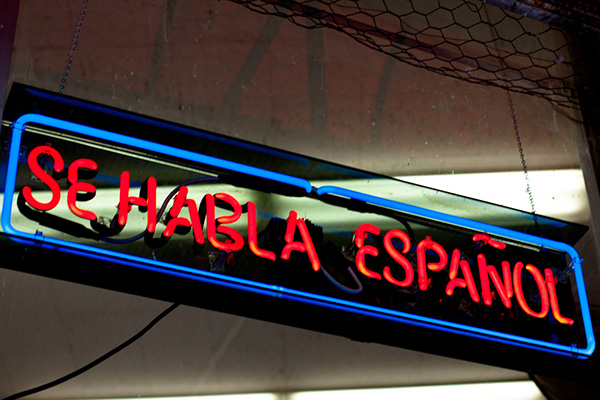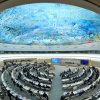Original version in Spanish: Torres y muros frente al multiculturalismo: hispanos y español en la presidencia de Donald Trump
Theme
The election of Donald Trump has generated new tensions around the public use of Spanish in the US and, above all, over multiculturalism.
Summary
The arrival of Donald Trump to the White House has generated new tensions around the public use of Spanish in the US, but also over multiculturalism as a paradigm for public policies in the country. Spanish has been used by President Trump to visualise the supposed risks posed by a language and a community –Spanish and Hispanics– for whom cultural assimilation does not appear, for diverse reasons, to be as profound as among other language communities. This analysis reviews the delicate relationship between Hispanics, Spanish, the rise of ‘paleoconservatism’ and Donald Trump during the last 12 months, beginning with his oath of office as the 45th US President.
Analysis
‘Does not the irrational have as much value as the rational?’
(Alfred Jarry, Ubu Roi, 1896)
Twelve months still seems to have been an insufficient period of time for the large part of US society (and the international community) to assimilate the electoral victory of the Republican Party candidate, Donald Trump. In 2016, Trump stepped into a profoundly fractured political and social scenario in which the GOP had been suffering from tensions generated by the rise of populism within its own ranks ever since the choice of the Governor of Alaska, Sarah Palin, as the Vice-Presidential candidate of John McCain in the 2008 presidential election. In the weeks preceding that election, the subprime loan and banking crisis, the collapse of Lehman Brothers, the bank bailout1 undertaken by George W. Bush and the victory of Obama all reinforced the most radical sectors of the party, rapidly organised around the so-called ‘Tea Party’.
The Republican discontent provoked by the bank rescue package –which many interpreted as a betrayal of free market principles and an act of capitulation by Bush, McCain and Obama to the economic establishment and to state interventionism– together with the policies of Obama and the effect of the ongoing US economic transformation, have progressively nurtured ultra-nationalist movements within the Republican political space that have further consolidated the change in political cycle marked by the 2016 presidential elections. In 2008 the renovator of US conservative thought, the philosophy and political scientist, Paul E. Gottfried baptised the movement the ‘alternative Right’ (also known as the ‘alt-right’). His revision of conservative thought captures well certain key elements of Trump’s agenda, both expressed during the campaign and witnessed during his first months in the oval office: nationalism, strongly anti-statist and anti-establishment liberalism, and rebellion against multiculturalism2 and anti-feminism. Gottfried clearly identifies the adversaries:
‘In Western Europe and North America, this state3 rests its power upon a multitiered following: an underclass and now middle-class welfariate, a self-assertive public sector, and a vanguard of media and journalistic public defenders. Upon the basis of this following, the regime and its apologists have been able to marginalize their opposition’.4
If the last two decades have been characterized by the neoconservative hegemony of the Republican Party, this new period appears to be dominated by so-called ‘paleoconservativism’, which distances itself from the US liberal tradition of the founding fathers:
‘The fundamental difference between neoconservatism and paleoconservatism is this: neoconservatives belong to the tradition of liberal-democratic modernity, the tradition of Montesquieu, Madison, and Tocqueville; paleoconservatives are the heirs to the Christian and aristocratic Middle Ages, to Augustine, Aquinas, and Hooker. The principles of neoconservatism are individual liberty, self-government, and equality of opportunity; those of paleoconservatism are religious –particularly Christian– belief, hierarchy, and prescription’. 5
Many organisations have been involved in this process of ideological rearming, both in the academic-university arena and among the political and social organisations of civil society. Some of them are very close to the extreme right, hold white supremacist views and have been implicated in episodes of violence and radical exaltation, including cries of ‘Heil Trump’ that saluted the Republican victory at an event of the National Policy Institute of Richard Spencer.6 These social and political movements of the ultra-right found a liberal populist icon in Donald Trump, capable of defying the Republican Party establishment and the rest of the dominant actors on the national and international scene.
The Trump Tower: a ‘truthful hyperbole’
Trump, as President, is not the same person that the average American had witnessed rise with time, and then collapse, only to come back and rise again: the man who avoided New York traffic jams by taking a helicopter and battled through his divorces in public. Now that he is in politics, Americans have a champion of the middle class committed to bringing justice upon the Washington establishment.
Despite the omnipresence of US popular culture, the world only became aware of Trump during the election campaigns –the Republican primaries and the presidential election– in 2016. For the average American, however, Trump has for many years now formed part of the viscous electronic flow of television programmes and the ink waves of the popular press of the last four decades, when the ‘star system’ exported by the US cultural industry only included movie and television actors and actresses. Today, however, the Kardashian family and the employees of a Las Vegas pawnshop, for example, have become a central part of the television imagination of everyone. The ‘spectacle-isation of the quotidian’ has made ‘reality shows’ the primary content of hundreds of channels. But back in the 1980s and 1990s, the US social ‘star system’ had not yet embraced the ‘reality show’ that already served as part of the domestic diet on television and in local tabloids like the New York Post and the Daily News.
On the front pages of the daily papers stacked in front of subway cars and buses, Trump constructed his public persona as a man of success who adorned the Olympic heights of the city: his real-estate projects and his gambling tables at the Taj Mahal7 in Atlantic City, his divorces and weddings, his betrayals and victories, his bankruptcies and his constant resurrections were all minutely dissected in the society columns of the popular New York daily papers. As he said in 1987, ‘I don’t mind controversy, and my deals tend to be somewhat ambitious. Also, I achieved a lot when I was very young, and I chose to live in a certain style. The result is that the press has always wanted to write about me’.8 The construction of Trump Tower in Manhattan (1979-83) symbolically confirmed his position within the super-rich of the Big Apple and the triumph of the American myth of the self-made man –even if this grandson of German immigrants and son of a Scottish immigrant had a privileged upbringing and life, supported by the economic success of the real estate businesses of his father, Fred Trump–. But the Trump Tower is above all the metaphor for his famous notion of ‘truthful hyperbole’, the foundation of his communications strategy: ‘an innocent form of exaggeration – and a very effective form of promotion’.9 Since then, skyscrapers with his name –plastered across their façades– have served as symbols of his business success in Chicago, Honolulu, Las Vegas, Washing, Sunny Isles, White Plains, Istanbul, Pune, Kolkata, Vancouver and Panama; and others in Punta del Este, Mumbai and Manila are about to be completed.
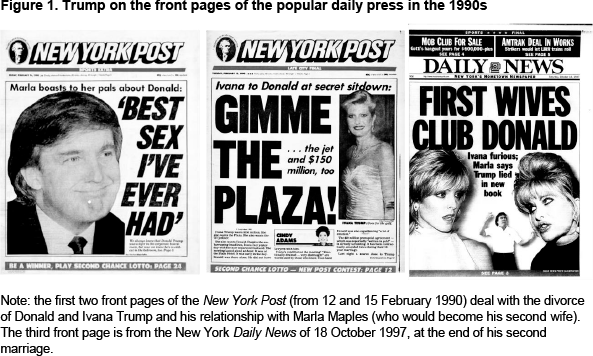
His frequent appearances on television (in series and movies, on his own ‘reality show,’ The Apprentice, and in the commercial advertisements of McDonalds, Nike, PizzaHut and Visa) have been the key that has allowed him to maintain a long-running presence in US popular culture. He has been very conscious of the fact that the central element of his business brand is nothing other than himself, wrapped in his trademark suit (of which he produced a collection for the department store Macy’s). This is the way in which the myths of popular culture are created, by divulging and sharing the ups and downs of a figure’s public and private life. ‘Good publicity is preferable to bad, but from a bottom-line perspective, bad publicity is sometimes better’.10 More than anything, controversy guarantees media coverage. A study by MediaQuant, a consultancy, valued Trump’s media presence during the campaign at US$5 billion.11 The 14 seasons of The Apprentice,12 and the permanent coverage of Trump’s activities on the talk shows and in the social reporting of NBC, created a mass of spectator-voters and a weekly stage on which Trump constructed his public persona of success, leadership and firmness. Trump as President appears to project this conception of personal leadership in all its dimensions –l’état c’est Trump– as Roger Cohen brilliantly summarised in the New York Times.
The ‘Divided States’ of America: ‘nobody builds walls better than me’
In the face of (1) the financial crisis of 2007-08, (2) intensifying deregulation, (3) deepening globalisation of economic flows and processes and (4) digitalisation and automatisation, the middle and lower-middle classes have weathered unprecedented years of economic weakness and vulnerability, enduring an unemployment rate13 which reached 10% in October 2009 –a level last surpassed in the recession of the early 1980s (1982-83)–. In this context, immigration easily became the target of President Trump’s ire, and he projected upon on it the fears of the country’s most vulnerable citizens.
The social, political and economic conditions of the US continue to exert a strong attraction on people from all over the world. This is also the result of the country’s permanent effort to project an idyllic image of itself through its instruments of soft power. Data from the Office of Migrations show how in recent years the admission of legal immigrants has been intense, comparable only –historically– to the period 1910-20: between 2005 and 2016 at least a million legal immigrants came to the country each year.14 Today foreigners make up 13.5% of the total US population –a relative weight similar15 to that of the decade of the 1920s– although, at 43.7 million, the absolute size of this population group is the highest in the country’s history. To these should be added undocumented immigrants, some 11 million according to an estimate by the Migration Policy Institute, half (56%) from Mexico16 and 80% from Latin America.

The overlap of this intense inflow of foreigners in the last decade with the economic crisis that generated the highest unemployment rate since the 1980s produced a scenario in which the populist and polarising discourse of Donald Trump has rapidly and easily caught fire. Excluded from the political processes –although a key factor in the economy– immigrants are vulnerable and easy targets for this kind of electoral message. Of the 43.7 million foreigners residing in the US and registered by the Census Bureau in 2015, 51% came from Latin America and of these 27% were from Mexico.17 To place the focus upon Spanish is, in fact, to put it on Hispanics, the most identifiable stereotype of the immigrant population for the average US citizen.
The President’s list of complaints with Hispanics goes a long way back, but here we limit the discussion to the past two years. On 16 June 2015, surrounded by the marble and gold of his New York castle, Trump announced his presidential campaign and devoted the central part of his message to Mexican immigration:
‘When Mexico sends its people, they’re not sending their best. They’re not sending you. They’re not sending you. They’re sending people that have lots of problems, and they’re bringing those problems with us. They’re bringing drugs. They’re bringing crime. They’re rapists. And some, I assume, are good people… And it’s got to stop and it’s got to stop fast.’18
In the collective US memory, these words evoked the marielitos from Cuba in 1980, and fed the line of his claim, in 2013, that the rise in crime in the US was due to blacks and Hispanics.19 Perhaps because of this, at this very same event, Trump announced the construction of a great wall (‘and nobody builds walls better than me’, he said) along the southern border, ‘and I will have Mexico pay for that wall. Mark my words’.20 Hispanic immigration has become for Trump a symbol of the ‘un-American’, of the foreign, the ‘bad’ coming from abroad that his presidency has pledged to eradicate, so as to return to a better past, giving the English language the status of the central symbol of (a particular) national identity.
Spanish is foreign, strange, spoken by the ‘other’. At a campaign event in Keene (New Hampshire), Trump accused Marco Rubio of wanting to open the borders: ‘(He m)ade a speech not so long ago, in Spanish, saying he wants to open up the borders essentially. He didn’t want you people hearing it, so he made the speech in Spanish. That’s true’.21 In the 19th century Tocqueville pointed to linguistic unity as one of the keys to the success of the US,22 but much has changed since then; as Hernández Nieto emphasises, the US faces a collective problem in that 8% of its population –and 18.9% in California– ‘does not understand the majority language of the country and the language of the public administration, or can only maintain very basic communication in it’.23 For Trump, the division in the US is not political or economic: it is over identity, and the perceived loss of English is an alarm signal. This division is the fruit of erroneous past actions, not of the political action of Trump himself, even if it appears to serve the goal of polarisation, the central axis of his political communications strategy.
Raising an administrative wall: ‘speak English, not Spanish!’
Although the US Constitution recognises no official language,24 attempts to make English official go back to 1923. Since 1981 different members of the Republican Party have led a total of six initiatives that, even if they have not been successful at the federal level, have been well-received in many states, thanks to organizations like US English25 and an intense lobbying effort. This movement, known as English Only –or, more precisely, English Official, because in many cases it does not advocate the prohibition of other languages, rather a predominant status for English– has spread across the country26 and has managed to get most of the states to approve laws making English the official language. By the late 20th century, five states had made English their official language (in Massachusetts the law was declared unconstitutional). During the last 20 years of the last century, with the rise of the English Only movement, 20 states approved such legislation. A more recent wave in which eight more states have passed related laws both presages and reflects linguistic and migratory tensions in many regions.27
In 2017, 32 states had some kind of legislation on the official nature of English.28 In most cases, these laws are symbolic declarations. Although they are of some political importance, because of the characteristic checks and balances of the US political system their practical impact on electoral, labour, tax or health law is very limited.29
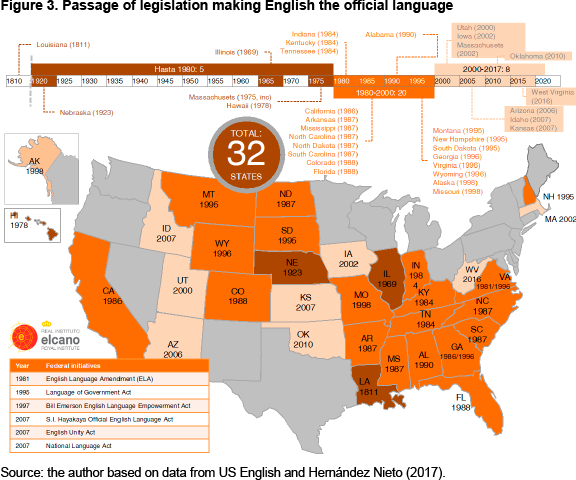
(Click to enlarge)
As could be expected, there is a direct relationship between these legislative initiatives and the size of the immigrant population, but a recent study identified a key legislative detonator: ‘When immigration receives of a lot of media coverage, the visibility of the issue seems to push the states… to respond with legislation making English the official language’. In defiance of the so-called ‘melting pot’ (in which the languages of immigrants are diluted over the decades), Spanish seems to resist as a result of the intense Hispanic immigration of the 1990s and the economic value that, for private companies, the Spanish language now represents in the form of a tool for accessing 50 million US Hispanics and their market power. Another case altogether is the political situation in the Free Associated State of Puerto Rico. The Republican Rick Santorum –later a rival of Trump in the Republican primaries– said before the Puerto Rican referendum of 2012 that if the island wanted to become a state it should have English as its principal language30 (the Constitution of 1952 only requires members of the Legislative Assembly to know either English or Spanish).31
This mono-multilinguistic cultural tension in an increasingly diverse US society is not, therefore, anything new. It reveals, rather, the permanent balances and readjustments that the US system maintains between the federal and state political levels, and it underlines the complexity of a country comprising 50 states, each with their own constitutions and laws, and with historical and social realities that are more diverse than often appear. The current international context in cultural policy favours a position that is respectful of multiculturalism, and this is recognised by the central driver of UNESCO since 2005, the ‘Convention for the Protection and Promotion of the Diversity of Cultural Expressions’. On the other hand, the US continues not to subscribe to the agreement and, what is more, a few years ago it announced its decision to abandon UNESCO once again in response to decisions taken by the organisation concerning world patrimony that went against the criteria of Israel. This US move is not only a form of support for Israel –or just a new rejection of multilateral instruments in international affairs– but also a declaration of rejection of the multicultural paradigm that has defined the activity of UNESCO for more than a decade.
The Trump presidency has taken on this line, defending the cultural assimilation32 of non-Anglophone cultures and looking askance at the use of Spanish. During the Republican primary campaign, he derided his rival Jeb Bush for speaking in Spanish at his campaign events: ‘He should set an example and speak English in the United States’.33 And on his Twitter account he posted: ‘Jeb Bush is crazy, who cares if he speaks Mexican, this is America, English!’.34 Even more clarifying were his words at a primary debate on 16 September 2015 in the Ronald Reagan Library in California:
‘We have a country, where, to assimilate, you have to speak English… We have to have assimilation – to have a country, we have to have assimilation. I’m not the first one to say this… We’ve had many people over the years, for many, many years, saying the same thing. This is a country where we speak English, not Spanish.’ (applause).35
This legitimisation of the public rejection of the use of Spanish –indeed, of any language other than English– has produced a multitude of small incidents of xenophobic social violence, like those reported by the website documentinghate.org of the NGO ProPublica. These have included reproaches of Latinos for speaking Spanish on the street or in schools, increasingly habitual insults –often using the derogatory term ‘spic’–36 and political cries used as a form of aggression, as in the case of the white fans at a high school sporting event who shouted ‘Trump, Trump, Trump!’ at the players of the opposing team, made up mainly of Latinos and Afro-Americans. As The New York Times tragically concluded, the name of the president had been transformed into a racial jeer.37
The communicational wall: ‘the page you’re looking for can’t be found’
Just as the degradation of the Hispanic was present from the first moments of Trump’s announcement as a presidential candidate, and just as the border wall formed part of his campaign, the ‘communicational wall’ began a few hours after taking the oath of office. On 23 January, the White House eliminated the Spanish version of its website –just as it also removed information concerning climate change and LGTBI collectives–. It was replaced with the message, in English: ‘The page you’re looking for can’t be found’. Despite statements of the White House Press Secretary claiming the same day that it was only a temporary adjustment of website content, a year later the White House page in Spanish continues to show the same message of non-existent content. Curiously, a group of volunteers has begun to work on a translation of the page, which will be available at whespanol.com.
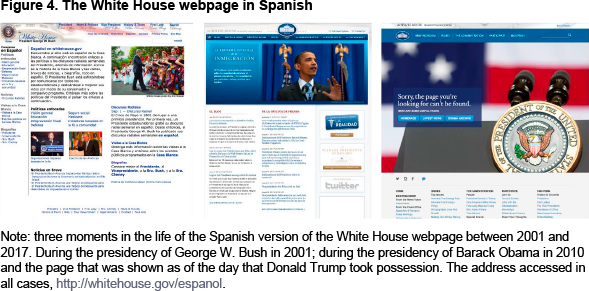
Trump’s favourite communications tool continues to be the social network Twitter, which he uses as a permanent mechanism for bypassing the media. Trump’s Twitter account @realDonaldTrump has more than 46 million followers and is among the top 20 most followed accounts in the world.38 The account in Spanish of the presidency on Twitter,39 @LaCasaBlanca, was not shut down after the oath of office, but during the first year it posted only 184 messages, with a follower rate per tweet of a bare 21,000. These figures cannot compare with those of the account in English, @WhiteHouse, which during the same period posted 2,800 messages with a rate of 1.3 million followers per tweet. Many of the tweets from the account @LaCasaBlanca were posted in English, and many others contained spelling errors or were poorly translated from other messages in English.
The same position has been taken with respect to the communications media. He has accused Hispanic –and what he calls ‘progressive’– media outlets of being the tools of the traditional political elite. Trump’s public communications representatives have tried to demonstrate that, in the face of the media’s agenda, there exists a different perspective on events which the President’s advisor, Kellyanne Conway, called ‘alternative facts’.40 The political polarisation of the country has in recent years led to a ‘polarised pluralism’ in the media,41 with Fox New (the news network of the 21st Century Fox corporation, and now in the process of being sold to Disney),42 various Internet sites and the always-politicised talk radio shows43 as the principal defenders of Trump’s discourse, range against the rest of the television stations that maintain a critical position towards the Trump presidency. The media reference for the Hispanic community, Univision, has frequently been the object of Trump’s ire, going back to before the campaign.44 The most visible confrontation was between the journalist Jorge Ramos and Trump during a press conference in Iowa on 25 August 2015, when Trump asked the security team to remove the Univision journalist from the room,45 telling him to ‘Go back to Univision’.
Conclusions
Towers and walls against multiculturalism
Trump’s public discourse has constantly utilised immigration, Hispanics and Spanish to simplify the causes of the middle-class economic crisis and to attract the votes of the discontented. Despite this, the polls showed considerable support among Latino voters, and the exit surveys revealed that Hispanics voted for Trump to the same degree46 (28%) as they did for the previous Republican candidate, Mitt Romney, in 2012. Nevertheless, these surveys were not designed methodologically for researching such specific population cohorts. In light of studies published in recent months, it appears that Trump’s Latino vote has been overestimated.47
And, despite everything, many Latinos voted for him. As explained in many previous analyses, the US Hispanic community is much more complex than is typically assumed. The decline in immigration means that more Mexicans are leaving the US than are entering,48 the generations most removed from the family migration process slowly lose Spanish (more than 26% of Hispanics no longer speak it at home)49 and a large majority of Hispanics no longer believe it is necessary to speak Spanish to be Hispanic (71%).50 The US Hispanic community is changing –not necessarily towards assimilation– and this transformation complicates any analysis of Hispanic support for Trump (minority, in any case) based on the traditional stereotypes.
It is difficult to make future projections, but some reactions suggest that the battle between multiculturalism and paleoconservatism will be a long one. As pointed out in the last report of the US Observatory of the Cervantes Institute, the same day Donald Trump won the elections, Californians voted in a referendum (73.52%) to restore bilingual education, and just a few weeks ago Massachusetts did so as well.51 At the same time, the ‘Seal of Biliteracy’ –a certificate awarded to students demonstrating knowledge of two or more languages by the end of secondary school–52 has been adopted in many states (29 plus Washington DC), and general data on the teaching of Spanish reveals that it as the most studied language in the US at all levels.53 In any case, Trump’s distance from Spanish and the Hispanic community is clear. The President is determined to build walls against illegal immigration, against cultural diversity (which for him threatens the greatness of the US), against the political and economic establishment that he feels ignores the interests of the middle class. Such walls continue to attract paleoconservative thought now emerging in many sectors of the country. But such walls are also contributing to even deeper divisions –ideological, ethnic and economic– in US society.
The hyperbole and the bravado that Trump confessed in 1987 to be the essence of his public communications strategy does not appear to be the best way to conduct politics (domestic or international). Most observers still perceive more bravado and hyperbole at the end of Trump’s first year than any effective threats: ‘Don’t read too much into it’, as the members of his own government recommend to people, for example, with respect to his threats to North Korea.54 But the effects of Trump’s actions are real –and could end up out of control–. The total personalisation of government and the identity between Trump and the nation –which Lakoff identifies as the key metaphor of this period–55 should give us plenty of reasons for worry, as the President appears more interested in his own immediate success –in always being seen as victorious in every moment– than he is in taking other mid- and long-term decisions with objectives other that just reinforcing (supposedly lost) US hegemony. In his classes in 1975, the French sociologist Michel Foucault introduced a concept that combined wretchedness, the ridiculous and the majesty of power (maiestas) into a sense of the ‘ludicrous’, the grotesque portrait of power imagined by Alfred Jarry in 1896 in Ubu Roi. No other adjective could summarise better, or with less astonishment, the past 12 months.
Ángel Badillo Matos
Senior Analyst, Real Instituto Elcano | @angelbadillo
1 The bank rescue was called the Troubled Asset Relief Program (TARP) and required an investment of US$205 billion. See ‘The Legacy of TARP’s Bank Bailout Known as the Capital Purchase Program’, revision undertaken by the Special Inspector General for the Troubled Asset Relief Program in January in 2015.
2 ‘Such a society does not arise unbidden but to a large extent is molded by government policies toward particular minorities and through the promotion of Third World immigration as an instrument of internal change… In the new multicultural as opposed to conventional multiethnic situation, the state glorifies differences from the way of life associated with the once majority population’. In P. Gottfried (2004), Multiculturalism and the Politics of Guilt, University of Missouri, p. 16.
3 In the original, “this state” refers to the “managerial state”, a pejorative term with which some authors criticise public management, claiming that it has become an end in itself, and which they try to use as a basis for the reform of the welfare state.
4 In P.E Gottfried (1999), After Liberalism: Mass Democracy in the Managerial State, Princeton University Press, Princeton, p. 139.
5 In G.L. Schneider (2013), Conservatism in America Since 1930: A Reader, NYU Press, New York, p. 388.
6 See, for example, ‘“Hail Trump!”: white nationalists salute the President-Elect’, The Atlantic, 21/XI/2016.
7 The hotel has been rebaptized as the Hard Rock Hotel & Casino Atlantic City. It will reopen its doors in the summer of 2018.
8 See Donald J. Trump and Tony Schwartz (1987), Trump: The Art of the Deal, Random House.
9 Ibid.
10 Ibid.
11 Mary Harris (2016), ‘A media post-mortem on the 2016 presidential election’, MediaQuant, 14/XI/2016.
12 The programme was aired for the first time by NBC on 8 January 2004; as of the seventh season (2008) it was called The Celebrity Apprentice. It was suspended in 2015 after the airing of the 14th season, only to return in 2017 (although now without Donald Trump as host; he was substituted by the actor and former Governor of California, Arnold Schwarzenegger).
13 The time series can be consulted at the Bureau of Labor Statistics.
14 Between 1904 and 1914, the US granted legal status to nearly 11 million immigrants; this 10-year cumulative figure is the highest in US history except for the decade 1999-2009. See Migration Policy Institute (2017), ‘Annual number of new legal permanent residents, fiscal years 1820 to 2016’.
15 The percentage of immigrants in the US was 13.2% of the population and in 2016 it was 13.5%.
16 MPI, ‘Unauthorized immigrant population profiles’.
17 Data from American Community Surveys (IPUMS).
18 See http://time.com/3923128/donald-trump-announcement-speech/.
20 The CSPAN transcription of this part of the speech reads: ‘I would build a great wall, and nobody builds walls better than me, believe me, and I’ll build them very inexpensively, I will build a great, great wall on our southern border. And I will have Mexico pay for that wall. Mark my words’.
21 From the CSPAN transcription.
22 ‘The immigrants who came, in different periods, to occupy the territory which today covers the United States of America, differed from each other in many ways: their objectives were not the same, and they governed themselves according to different principles. These men nevertheless had common traits among them, and the all found themselves in an analogous situation. The tie of language is perhaps the strongest and most durable that binds peoples. All the immigrants spoke a common language; they were children of the same country’, in A. de Tocqueville (1835), Democracy in America.
23 R. Hernández Nieto (2017), ‘La legislación lingüística en los Estados Unidos’, Observatorio de la Lengua Española y las Culturas Hispánicas en EEUU, Instituto Cervantes, Boston.
24 Most states have approved laws declaring English the official language, others have various official languages and some have none.
25 See https://www.usenglish.org/.
26 Amy H. Liu & A.E. Sokhey (2014), ‘When and why do US states make English their official language?’, The Washington Post, 18/VI/2014; and A.H. Liu et al. (2014), ‘Immigrant threat and national salience: understanding the “English official” movement in the United States’, Research & Politics, vol. 1, nr 1, pp. 1-8.
27 See Hernández Nieto (2017), p. 12 and following.
28 US English, ‘Official English: what is official English’.
29 See Hernández Nieto (2017), p. 88 and following.
30 Santorum clarified some days later that his statements had been distorted: ‘Whether or not English is the language here, English should be taught’ (EFE, 16/III/2012). The referendum in Puerto Rico, held in 2012, resulted in a victory for those in favour of statehood.
31 See Section 5, Constitution of the Free Associated State of Puerto Rico, 1952.
32 The term ‘cultural assimilation’ is used in the sociology of culture to define the incorporation of a foreign culture into a host culture that receives it, viewing this process as beneficial for both. It was used in the first half of the 20th century for explaining the non-violent nature of the cultural homogenization process in the US. One of its origins is the concept of the melting pot, popularised by the work of Israel Zangwill, particularly ‘America is God’s Crucible, the great Melting-Pot where all the races of Europe are melting and re-forming’, in The Melting Pot, 1908.
33 Matthew Boyle (2015), ‘Exclusive: Donald Trump fires back at Jeb Bush: he should lead by “speaking English” while in the United States’, Breitbart News, 5/IX/2015.
34 ‘Jeb Bush is crazy, who cares that he speaks Mexican, this is America, English !!’, 25/VIII/2015, 3:14, @realDonaldTrump.
35 In the transcript of The Washington Post.
36 In the opinion of the researcher Frances Negrón-Muntaner, the term significantly predates that of ‘Hispanic’. It was created by Americans during the construction of the Panama Canal to refer to the local workers who did not speak English (no speak English), and it evolved into the actual form, ‘spic.’
37 D. Barry y J. Eligon (2017), ‘“Trump, Trump, Trump!” How a President’s name became a racial jeer’, The New York Times, 16/XII/2017.
38 The data is from January 2018; at this moment, the most followed Twitter account belongs to the singer Katy Perry (108 million followers) and she is followed in the list by the singer Justin Bieber (105 million) and the former US President Barack Obama (98 million).
39 Both Twitter accounts, @WhiteHouse and @LaCasaBlanca, were created in January 2017.
40 Statements on the NBC programme Meet the Press, 22/I/2017.
41 Using the terminology of Daniel Hallin and Paolo Mancini. See D.C. Hallin & P. Mancini (2004), Comparing Media Systems: Three Models of Media and Politics, Cambridge University Press, Cambridge.
43 Talk radio is the name given to US radio stations that air mainly programming based on spoken content and the participation of the audience. Talk radio began to spread in the 1990s, after the Fairness Doctrine (the principle that obliges radio stations to maintain ideological equilibrium in their content) was declared unconstitutional in 1987.
44 In 2015 Trump sued Univision when, after his speech announcing his presidential candidacy, the Spanish-language channel decided to rescind the contract it had with Trump for broadcasting the contents of the Miss Universe contest.
45 See, for example, http://www.bbc.com/mundo/noticias/2015/08/150826_eeuu_donald_trump_rueda_prensa_jorge_ramos_expulsion_jg.
46 Hillary Clinton enjoyed less support from the Hispanic electorate than Barack Obama (66% compared with 71%), according to the same surveys. In this regard, see the publications of Pew Research.
47 See, for example, M. Barreto and G. Segura (2017), “Understanding Latino voting strength in 2016 and beyond: why culturally competent research matters,” Journal of Cultural Marketing Strategy, vol. 2, nº 2, pp. 190-201. See also, “Did Latino voters actually turn out for Trump in the election? Not really,” Los Angeles Times, 11/I/2017.
48 See: http://www.pewhispanic.org/2012/04/23/net-migration-from-mexico-falls-to-zero-and-perhaps-less/.
49 See: J.M. Krogstad, R. Stepler and M.H. López (2015), “English proficiency on the rise among Latinos,” Pew Research Center, 12/V/2015.
51 On the results of the California referendum (Proposition 58). On the reform of the Massachusetts educational system and the Language Opportunity for Our Kids (LOOK) program.
52 See: http://sealofbiliteracy.org/.
53 See the “Mapa Hispano de los Estados Unidos 2017” that is published each year by the Observatory for the Spanish Language and Hispanic Cultures of the Cervantes Institute, pp. 30-32.
54 According to the commentary of the political analyst, Josh Dawsey, in Twitter.
55 See https://georgelakoff.com/2017/08/01/the-president-is-the-nation-the-central-metaphor-trump-lives-by/.
